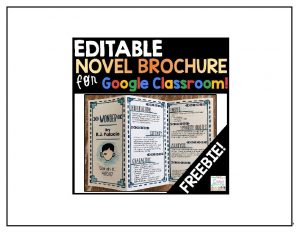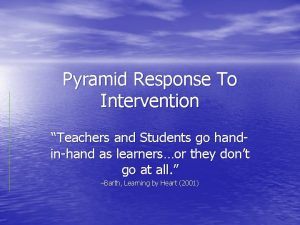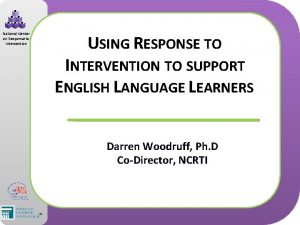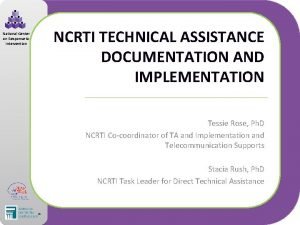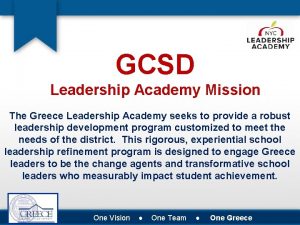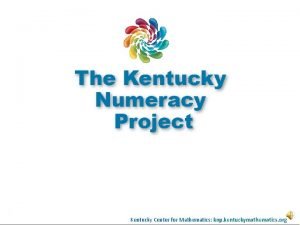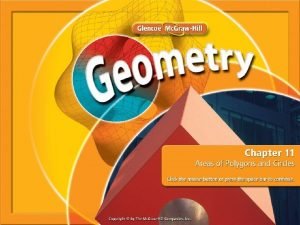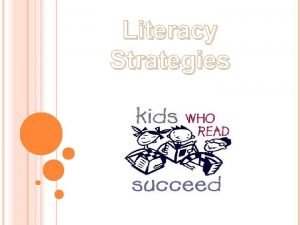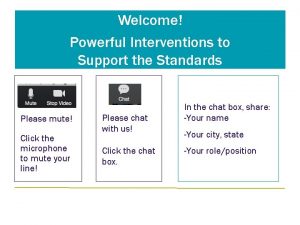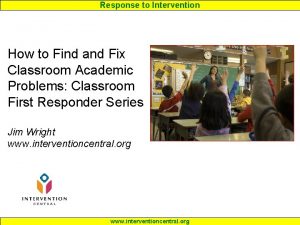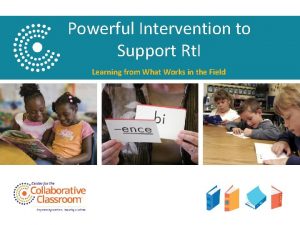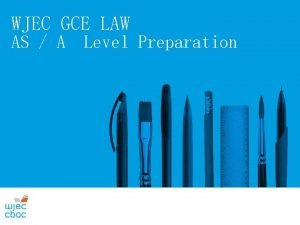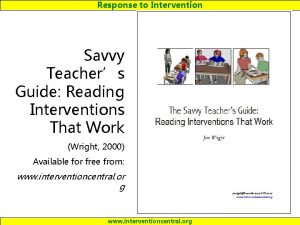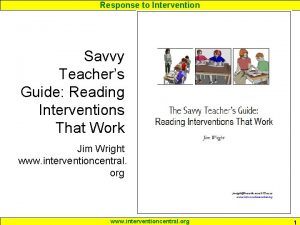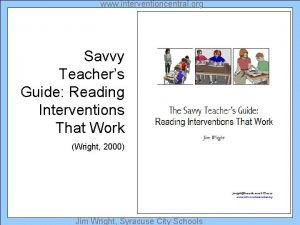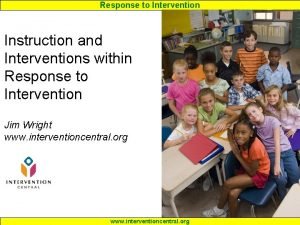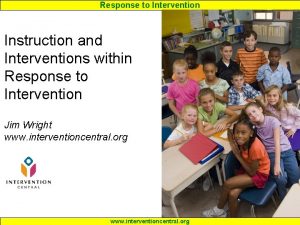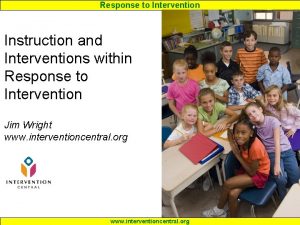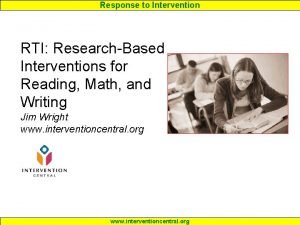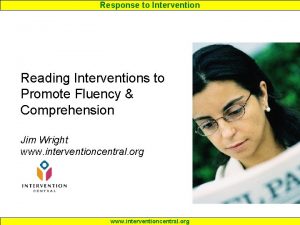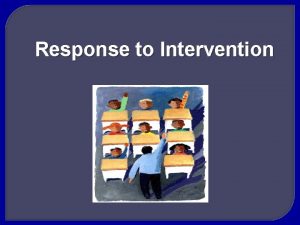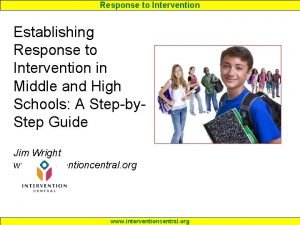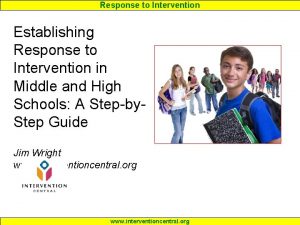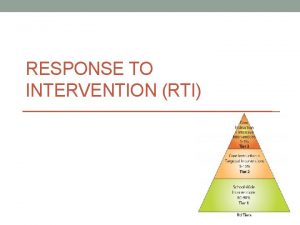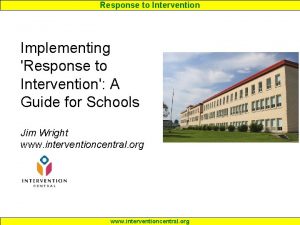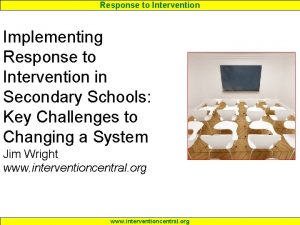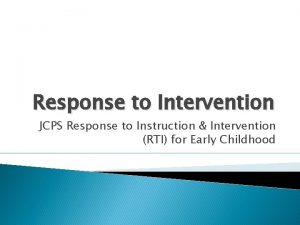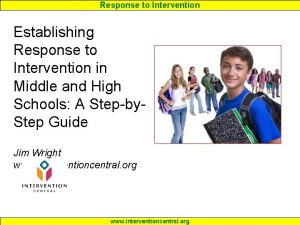Response to Intervention Savvy Teachers Guide Reading Interventions




















- Slides: 20

Response to Intervention Savvy Teacher’s Guide: Reading Interventions That Work (Wright, 2000) www. interventioncentral. org 1

Response to Interventions for…Increasing Reading Fluency • Assisted Reading Practice • Listening Passage Preview (‘Listening While Reading’) • Paired Reading • Repeated Reading www. interventioncentral. org 2

Response to Intervention Comprehension Interventions That Rely on ‘Gist’ Sentences • ‘Click or Clunk? ’ Self-Check • Keywords: A Memorization Strategy • Main Idea Maps • Mental Imagery: Improving Text Recall • Oral Recitation Lesson • Prior Knowledge: Activating the ‘Known’ • Question-Generation • Reciprocal Teaching: A Reading Comprehension Package • Story Map • Text Lookbackwww. interventioncentral. org 3

Response to Intervention http: //www. nichd. nih. gov/publications/nrppubskey. cfm www. interventioncentral. org 4

Response to Intervention Building Reading Fluency www. interventioncentral. org 5

Response to Intervention Reading Decoding ‘…Of course, when children cannot decode at all, there is little chance of comprehension. When they can decode but it requires a considerable effort, decoding competes with comprehension efforts for the limited capacity available for processing of text…so that effortful decoding consumes capacity that might otherwise be used to understand text. ’ - Pressley & Wharton-Mc. Donald, 1997 www. interventioncentral. org 6

Response to Intervention NRP Conclusions Regarding Importance of Oral Reading Fluency: “An extensive review of the literature indicates that classroom practices that encourage repeated oral reading with feedback and guidance leads to meaningful improvements in reading expertise for students—for good readers as well as those who are experiencing difficulties. ”-p. 3 -3 www. interventioncentral. org 7

Response to Interventions for…Increasing Reading Fluency • Assisted Reading Practice • Listening Passage Preview (‘Listening While Reading’) • Paired Reading • Repeated Reading www. interventioncentral. org 8

Response to Intervention Paired Reading (p. 17) The student reads aloud in tandem with an accomplished reader. At a student signal, the helping reader stops reading, while the student continues on. When the student commits a reading error, the helping reader resumes www. interventioncentral. org 9

Response to Intervention Building Reading Comprehension www. interventioncentral. org 10

Response to Intervention Reading Comprehension Skills Checklist: 2. 30 www. interventioncentral. org 11

Response to Intervention Processing Before Reading (Pressley & Wharton-Mc. Donald, 1997) • Good readers – have clear goals in mind before reading – overview the text before reading to: • determine whether text is worth reading • identify sections that may be most relevant • Create a ‘reading plan’ www. interventioncentral. org 12

Response to Intervention Processing During Reading (Pressley & Wharton-Mc. Donald, 1997) • Good readers – pay ‘differential’ attention to information that pertains to their goals – may jump back and forth in the text to clarify confusion, review specific information – anticipate what will come next in the text and updare their predictions based on new information – make inferences based on reading – ‘demonstrate passion’ for their reading www. interventioncentral. org 13

Response to Intervention Processing After Reading (Pressley & Wharton-Mc. Donald, 1997) • Good readers – may reread or ‘reskim’ the text just read – may take notes on text or attempt to restate main ideas – continue to think about and reflect on text once they are done reading www. interventioncentral. org 14

Response to Intervention Comprehension Interventions That Rely on ‘Gist’ Sentences • ‘Click or Clunk? ’ Self-Check • Keywords: A Memorization Strategy • Main Idea Maps • Mental Imagery: Improving Text Recall • Oral Recitation Lesson • Prior Knowledge: Activating the ‘Known’ • Question-Generation • Reciprocal Teaching: A Reading Comprehension Package • Story Map • Text Lookbackwww. interventioncentral. org 15

Response to Intervention Create a ‘gist’ sentence for this passage… ‘…when skilled readers read, they implicitly parse the text into micropropositions, the smallest units of meaning that can be conceived as verbs or prepositions as well as semantic roles that are related by the verbs or prepositions. All of the micropropositions specified in a text combine to capture the full meaning of the text. Of course, no one remembers every idea specified in a text. What people remember is the gist-the main idea of the www. interventioncentral. org text. ’- Pressley & Wharton-Mc. Donald, 1997 16

Response to Intervention ‘Click or Clunk’ Self. Check (p. 25) Students periodically check their understanding of sentences, paragraphs, and pages of text as they read. When students encounter problems with vocabulary or comprehension, they use a checklist to apply www. interventioncentral. org 17

Response to Intervention ‘Click or Clunk’ Check Sheet www. interventioncentral. org 18

Response to Intervention ‘Click or Clunk? ’ Example ‘…The of of lack of practice, deficient ‘…The combination lack of practice, decoding and difficult results deficient skills, decoding skills, materials and difficult in unrewarding early experiences materials results inreading unrewarding early that lead to less involvement in reading experiences that lead to less related activities. Lack and Lackofofexposure and involvement in reading related activities. practice on the part of of thethe less skilled readers practice on the part skilled Lack ofthe exposure and practice on the part of delays development of automaticity and readers delays the development of the less skilled readers delays the speed at the word-metacognition level. Slow, automaticity and speed at the worddevelopment of automaticity and speed at capacity-draining word-recognition processes capacity-draining word-recognition metacognition level. Slow, capacitythe word-metacognition level. Slow, capacityrequire cognitive resources that resources should be processes require cognitive draining word-recognition processes require allocated to higher-level process of text that should be allocated to higher-level cognitive resources that should integration and comprehension. ’be allocated process of text integration and to higher-level process of text integration and www. interventioncentral. org 19

Response to Intervention ‘Student Reader’ Activity In your ‘elbow groups’: Review the ‘Reading Comprehension Checklist’ (p. 8) Identify the 2 -3 most frequent or important ‘comprehension blockers’ that you have observed in the population of ‘difficult-to-teach’ students with whom you work. Be prepared to sharewww. interventioncentral. org your 20
 While reading activities
While reading activities Kim kroll teachers pay teachers
Kim kroll teachers pay teachers Savvy food safety
Savvy food safety Student savvy
Student savvy Savvy saving seniors
Savvy saving seniors How to be savvy online when shopping
How to be savvy online when shopping Political savvy pdf
Political savvy pdf Body language savvy
Body language savvy Pyramid response to intervention
Pyramid response to intervention National center for response to intervention
National center for response to intervention Ncrti
Ncrti Simplifying response to intervention
Simplifying response to intervention Kentucky center for mathematics
Kentucky center for mathematics 6-5 study guide and intervention rhombi and squares
6-5 study guide and intervention rhombi and squares 11-1 area of parallelograms and triangles
11-1 area of parallelograms and triangles Lli reading intervention
Lli reading intervention Sipps online resources
Sipps online resources Intervention central reading fluency
Intervention central reading fluency Ccclearninghub
Ccclearninghub Wjec law a level
Wjec law a level Theteachersguide.com
Theteachersguide.com



